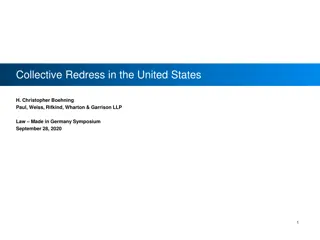
Globalization, Trade, and Comparative Advantage
Explore the significance of global marketing, trade, and specialization in international economics. Learn about the production possibilities frontier, comparative vs. absolute advantage, and the benefits of free trade and fair trade practices.
Download Presentation

Please find below an Image/Link to download the presentation.
The content on the website is provided AS IS for your information and personal use only. It may not be sold, licensed, or shared on other websites without obtaining consent from the author. If you encounter any issues during the download, it is possible that the publisher has removed the file from their server.
You are allowed to download the files provided on this website for personal or commercial use, subject to the condition that they are used lawfully. All files are the property of their respective owners.
The content on the website is provided AS IS for your information and personal use only. It may not be sold, licensed, or shared on other websites without obtaining consent from the author.
E N D
Presentation Transcript
International Environment Trade, Globalization 31st of January
Globalization Marketing products and services around the world Increasing world merchandise trade Big Emerging Markets (BEMs) Disposable income level International wants and desires
Why global marketing is imperative Saturation of domestic markets Emerging markets Global competition Need for global cooperation Internet revolution The Internet adds a new dimension to global marketing E-commerce retailers gain substantial savings by selling online
The production possibilities frontier Australia can produce either 100 Agricultural products or 50 electronic products Malaysia can produce either 40 agricultural products or 50 electronic products.
World Output The need to specialize! When countries specialize world output increases.
Comparative advantage. The ability of a country to price a good at a lower opportunity cost than another country. Absolute advantage. The ability of a country to produce a good using a fewer resources than another country.
Another Comparative vs Absolute Advantage Example Assume that both France and Italy have enough resources to produce either wine or cheese, but not both. France can produce 20 units of wine or 10 units of cheese. The opportunity cost of each unit of wine, therefore, is 10 / 20, or 0.5 units of cheese. The opportunity cost of each unit of cheese is 20 / 10, or 2 units of wine. Italy is able to produce 30 units of wine or 22 units of cheese. Italy has an absolute advantage for the production of both wine and cheese its opportunity cost for cheese is 30 / 22, or 1.36 units of wine the cost of wine is 22 / 30, or 0.73 units of cheese. Because France's opportunity cost for the production of wine is lower than Italy's, it has the comparative advantage despite Italy being the more efficient producer. Italy's opportunity cost for cheese is lower, giving it both absolute and comparative advantage.
Free trade vs Fair Trade Free Trade The flow of good and services between countries without restrictions. Fair Trade a county should only reduce its barriers to entry if the other country does not have some sort of unfair competitive advantage. And also provided that the other country also reduces its trade barriers. Type of protections Embargo Tariff Quota
Common arguments for protection The infant industry argument New domestic industries need protection because it is not yet ready to compete. National Security argument. A nation should not be dependent on other countries for defense. Employment argument. Job increases in protected industries. Cheap foreign labor argument. Other countries have cheaper labour, it is difficult to compete.
Free Trade Agreements ASEAN Association of South Eastern Asian Nations EEC European Economic Community NAFTA North American Free Trade Agreement. APEC Asian Pacific Economic Cooperation.
Advantages of Free Trade Agreements 1. Increased economic growth. The U.S. Trade Representative Office estimates that NAFTA increased U.S. economic growth by 0.5% a year. 2. More dynamic business climate. Often, businesses were protected before the agreement. As a result, these local industries risked becoming stagnant and non-competitive on the global market. With the protection removed, they have the motivation to become a true global competitor. 3. Lower government spending. Many governments subsidize local industry segments. When these are removed after the trade agreement, those funds can be put to better use. 4. Foreign direct investment. Investors will flock to the country, adding much-needed capital to expand local industries and boost domestic businesses. It also brings in much needed U.S. dollars to many formerly isolated countries. 5. Expertise. Global companies have the expertise to develop local resources, especially in mining, oil drilling and manufacturing. They provide free training, in essence, to local businesses. 6. Technology transfer. Free trade allows local companies access to the latest technology and business practices from their foreign partners. More jobs. As local economies grow, so do job opportunities. Many provide job training as well. Source: https://www.thebalance.com/free-trade-agreement-pros-and-cons-3305845
Disadvantages of Free Trade Agreements 1. Increased jobs outsourcing. 2. Theft of intellectual property. Many developing countries don't have the same protection for patents, inventions, and new processes as the United States and the laws they do have aren't always strictly enforced 3. Crowd out domestic industries. Many emerging markets are traditional economies that rely on farming for most employment. These small family farms can't compete with subsidized agri- businesses in the developed countries. 4. Poor working conditions. Multi-national companies may relocate jobs to emerging market countries that don't have adequate labor protections. 5. Degradation of natural resources. Emerging market countries find their timber, minerals and other natural resources depleted as the multi-nationals move in. 6. Destruction of native cultures. As development moves into former pristine areas, indigenous cultures can be affected as local peoples are uprooted and often killed. 7. Reduced tax revenue. Without import tariffs and fees, many smaller countries must find ways to replace that revenue. Source: https://www.thebalance.com/free-trade-agreement-pros-and-cons-3305845
Supply and Demand for foreign exchange. When the SL Rupee is low or depreciates. Sri-Lankan goods and services will cost foreign consumers less. Foreigners will buy more SL products. For Sri-Lankans foreign products become more expensive. When the SL rupee is high or appreciates. SL goods will cost foreign consumers more. Foreigners will buy less SL products Sri-Lankans will buy more foreign products.
4 shifts in supply and demand of a currency. Taste and Preference. Relative Incomes Relative Price levels Relative Real Interest Rates Depreciation A fall in the price of one currency relative to another Appreciate A rise in the price of one currency relative to another.
World Political Climate Brexit Transfer of Power in the United States Impact of Covid and the status of vaccines. Free Trade Income Inequality China vs the West














